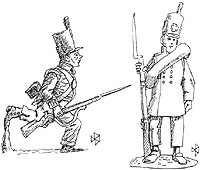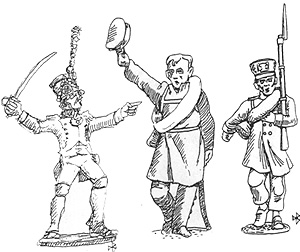 My Napoleonic figures are an eclectic assortment of 22 to 25mm figures from half a dozen manufacturers: Newline Design, Scruby, Hinton Hunt, Kreigspielers, Phoenix and others. I mount infantry five to a stand that is 1 x 3 inches in dimension. Each stand represents a company of French or a half company of Prussians. So, a French Infantry battalion is thirty-six figures on six stands while the corresponding Prussian battalion is forty figures on eight stands. Cavalry are mounted two figures per stand and six to twelve stands representing a regiment of horse. I mount guns one to a stand that represents a battery or company of artillery.
My Napoleonic figures are an eclectic assortment of 22 to 25mm figures from half a dozen manufacturers: Newline Design, Scruby, Hinton Hunt, Kreigspielers, Phoenix and others. I mount infantry five to a stand that is 1 x 3 inches in dimension. Each stand represents a company of French or a half company of Prussians. So, a French Infantry battalion is thirty-six figures on six stands while the corresponding Prussian battalion is forty figures on eight stands. Cavalry are mounted two figures per stand and six to twelve stands representing a regiment of horse. I mount guns one to a stand that represents a battery or company of artillery.
The French forces would enter the battle randomly and no set limit to the number that could be brought to bear against the Prussians. I had plenty of French line and light battalions and dragoons and guns to throw into the fray. In this solo game, I was playing the Prussians while the French were automated. So, a word about the Prussians.
The Prussians
Historically, Bulow's 4th Corps was the first of Blucher's army to advance against Napoleon's right flank. However, my figures derive from a variety of 1815 Prussian formations. I chose them as much for the wide variance in uniforms as for any desire to adhere to the historical order of battle. So, without further apologies, I offer you the Prussian forces that fought this battle.
 Nr. 9 Colbergsches Infanterie Regiment.
I only fielded two battalions of this regular regiment, the 1st battalion and the fusilier battalion.
Nr. 9 Colbergsches Infanterie Regiment.
I only fielded two battalions of this regular regiment, the 1st battalion and the fusilier battalion.
*1/9 Infantry This battalion is in standard Prussian regular infantry uniform of blue kollet (the tailed jacket) with white facings (collar and cuff) and red shoulder straps. Belts are white. Breeches are gray tucked into black gaiters. The shako is regulation and, in typical Prussian fashion, covered in oilskin.
*I use standard US military notation: the battalion followed by the regiment. Thus 1/9 is the first battalion of the 9th regiment. Fus/9 is the fusilier battalion of the 9th.
Fus/9 Infantry The fusilier battalion is identical to the first battalion except that belts are black.
Nr. 12 Brandenburgisches Infanterie Regiment. This regiment of three battalions was activated in July of 1813 and uniformed more like a reserve regiment.
1/12 Infantry I uniformed this regiment in the regulation shako with an oilskin cover. The short jacket is black with red color patches. The men wear white trousers.
2/12 Infantry The second battalion is in regulation uniform consisting of a blue kollet with red facings and white shoulder straps. They too are in oilskin covered shako.
3/12 Infantry The last battalion of this regiment wears light gray tailless jackets with crimson collar patches. Their trousers are white and they wear shakos with oilskin covers.
Nr. 21 (4th Pommeranian) Infanterie Regiment. This formation was initially formed as the 9th Reserve Infantry Regiment. I only have one battalion of this regiment, the 1st battalion.
1/21 Infantry The British provided this uniform which is cut pretty much like those provided to the Portuguese army. (I used a British light infantry figure.) The jacket and breeches are dark blue. The jacket sports green facings and shoulder rolls rather than shoulder straps. For headgear, the figures have stovepipe shakos with an oval plate topped with a white over red plume. Belts are black.
Nr. 1 Elbe Landwehr Regiment This formation was raised in late 1813 when the former Prussian lands that had formed the Kingdom of Westphalia were reoccupied by Prussians. While there was wide variance in landwehr uniforms and equipment, I kept mine "uniform."
1/1 Elbe Landwehr This battalion is uniformed in the blue litewka (long single-breasted coat with skirts) with light blue facings and shoulder straps. Trousers are white. Headgear is the low crowned blue schirmutze.
2/1 Elbe Landwehr. This battalion is uniformed identically with the first battalion except that the shoulder straps are red.
Nr. 2 East Prussian Jaeger battalion This rifle-equipped formation was uniformed in green kollet with red facings and shoulder straps. Breeches are gray and stuffed in to high black boots. The shako is covered in oilskin. All belts and straps are black.
The Prussians also have a heavy compliment of cavalry.
Nr. 1 Dragoner Regiment Koningin (the 1st Dragoons) This regiment of horsemen wears the medium blue litewka with crimson facings. The troopers also wear the oilskin-covered shako.
Nr. 5 Brandenburgisches Dragoner Regiment (the 5th Dragoons) Different from the 1st Dragoons, this regiment is in medium blue kollet with black facings. Trousers are gray.
Nr. 6 Sweites Schlesisches Husaren Regiment (the 6th Hussars) These colorful hussars are in green dolman and pelisse with scarlet facings and yellow lace. They wear gray riding breeches with scarlet and yellow "girdle" or wide belt. Troopers had black sheepskin shabraques edged with red "wolf's teeth" over the saddles.
I supported the Prussians with three batteries: a 6 # foot battery, a 12# foot battery, and a 6# horse battery.
Waterloo: The Paris Woods Scenario Part 1
Waterloo: The Paris Woods Scenario Part 2 [LW148]
Back to Table of Contents -- Lone Warrior # 147
Back to Lone Warrior List of Issues
Back to MagWeb Magazine List
© Copyright 2004 by Solo Wargamers Association.
This article appears in MagWeb.com (Magazine Web) on the Internet World Wide Web.
Other articles from military history and related magazines are available at http://www.magweb.com
